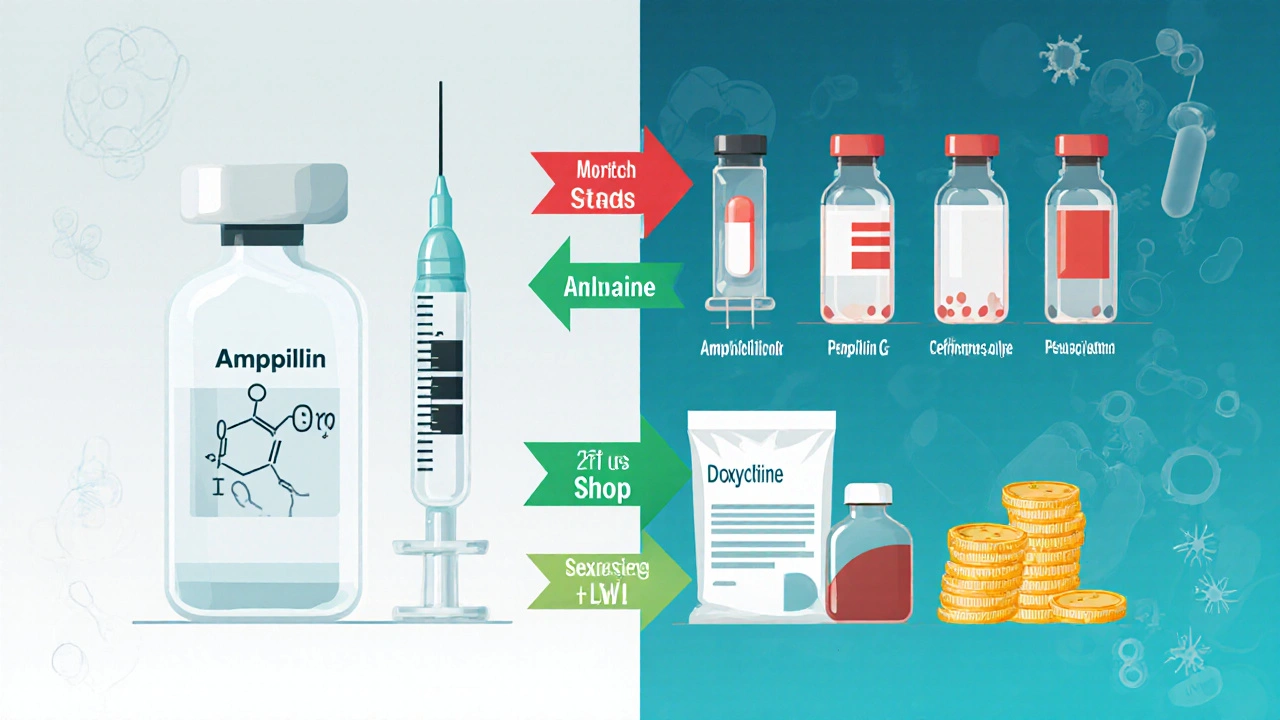 Oct, 5 2025
Oct, 5 2025
Antibiotic Choice Decision Tool
Recommended Antibiotics
Key Takeaways
- Ampicillin is a broad‑spectrum beta‑lactam antibiotic effective against many Gram‑negative and some Gram‑positive bacteria.
- It is given intravenously or intramuscularly, which limits its use for outpatient treatment.
- Common alternatives such as amoxicillin, penicillin G, cefazolin, azithromycin and doxycycline differ in route, spectrum, resistance risk and side‑effect profile.
- Choosing the right drug depends on infection type, patient allergies, local resistance patterns and cost considerations.
- Understanding each option’s strengths helps avoid treatment failure and unnecessary side effects.
What is Ampicillin?
Ampicillin is a semi‑synthetic penicillin‑derived antibiotic that belongs to the beta‑lactam class. Introduced in the early 1960s, it expanded the spectrum of the original penicillin G by adding activity against many Enterobacteriaceae, Haemophilus influenzae and some anaerobes. Because it is unstable in the acidic environment of the stomach, it is usually administered by injection (IV or IM).
How Ampicillin Works
The drug targets the bacterial cell wall. It binds to penicillin‑binding proteins, inhibiting the final steps of peptidoglycan synthesis. This weakens the wall, leading to osmotic rupture and cell death. The beta‑lactam ring is the key functional group responsible for this activity.

When Ampicillin Is Used
Clinicians prescribe Ampicillin for a range of infections, including:
- Lower respiratory tract infections caused by susceptible H. influenzae or Moraxella catarrhalis.
- Urinary tract infections where Escherichia coli is known to be sensitive.
- Meningitis in neonates caused by Listeria monocytogenes.
- Prophylaxis for certain surgical procedures.
Because resistance through beta‑lactamase production is common, Ampicillin is often combined with a beta‑lactamase inhibitor (e.g., sulbactam) to broaden coverage.
Strengths and Weaknesses of Ampicillin
Pros:
- Broad activity against many Gram‑negative bacilli.
- Well‑studied safety profile with decades of clinical use.
- Effective in severe infections when delivered IV.
Cons:
- Requires injection; not convenient for outpatient therapy.
- Susceptible to degradation by beta‑lactamases, limiting oral utility.
- Allergy cross‑reactivity with other penicillins.
Common Alternatives
When Ampicillin isn’t ideal, clinicians turn to other antibiotics that share or expand its coverage.
- Amoxicillin - an oral penicillin with a similar spectrum but better GI stability, often used for ear, sinus and dental infections.
- Penicillin G - a narrow‑spectrum agent targeting mainly Gram‑positive organisms; useful for syphilis or streptococcal infections.
- Cefazolin - a first‑generation cephalosporin given IV; retains beta‑lactam activity but resists many beta‑lactamases, making it a go‑to for surgical prophylaxis.
- Azithromycin - a macrolide with excellent tissue penetration; chosen for atypical pathogens and patients allergic to beta‑lactams.
- Doxycycline - a tetracycline class drug; covers a broad range of intracellular bacteria and is often used for Lyme disease or acne.

Side‑by‑Side Comparison
| Antibiotic | Spectrum | Typical Route | Common Indications | Main Side Effects | Resistance Concerns | Cost (US, generic) |
|---|---|---|---|---|---|---|
| Ampicillin | Broad Gram‑negative, some Gram‑positive | IV / IM | UTI, meningitis (neonates), intra‑abdominal infections | Diarrhea, rash, infusion site reactions | Beta‑lactamase producing organisms | ≈ $0.30 per dose |
| Amoxicillin | Similar to Ampicillin but better oral bioavailability | Oral | Otitis media, sinusitis, dental abscesses | GI upset, rash | Beta‑lactamase producers (often combined with clavulanate) | ≈ $0.15 per capsule |
| Penicillin G | Narrow, mainly Gram‑positive | IV / IM | Syphilis, streptococcal pharyngitis | Allergic reactions, neutropenia (rare) | Low; resistance rare in target organisms | ≈ $0.10 per dose |
| Cefazolin | Gram‑positive + many Gram‑negative, beta‑lactamase resistant | IV | Surgical prophylaxis, skin‑soft tissue infections | Phlebitis, mild GI upset | Emerging ESBL producers | ≈ $0.45 per dose |
| Azithromycin | Gram‑positive, atypical, some Gram‑negative | Oral (also IV) | Chlamydia, atypical pneumonia, community‑acquired infections | QT prolongation, GI upset | Macrolide‑mediated resistance rising | ≈ $0.60 per tablet |
| Doxycycline | Broad, includes intracellular bacteria | Oral | Lyme disease, acne, travel‑related diarrhea | Photosensitivity, esophageal irritation | Efflux‑pump resistance in some strains | ≈ $0.25 per capsule |
How to Choose the Right Antibiotic
Think of the decision as a simple flow:
- Identify the likely pathogen (culture results, local epidemiology).
- Check patient factors - allergies, renal/hepatic function, ability to take oral meds.
- Match the spectrum: if you need strong Gram‑negative coverage and can give IV, Ampicillin or Cefazolin may fit. For outpatient ear infections, Amoxicillin is usually cheaper and easier.
- Consider resistance: in areas with high beta‑lactamase rates, combine Ampicillin with sulbactam or switch to a beta‑lactamase‑stable option like Cefazolin.
- Balance cost and convenience - oral agents save hospital stay, but IV drugs may be required for severe sepsis.
Using this checklist helps avoid the common pitfall of “broad‑spectrum for everything,” which fuels resistance.
Practical Tips & Pitfalls
- Never mix penicillins with certain NSAIDs without checking for hypersensitivity cross‑reactivity.
- Monitor renal function when dosing IV Ampicillin in elderly patients; dose adjustments may be needed.
- If a patient develops a rash after the first dose, pause therapy and consider an allergy work‑up before switching.
- For outpatient therapy, prefer oral agents (Amoxicillin, Doxycycline, Azithromycin) unless the infection demands high blood levels.
- Document local antibiogram data - it often tips the scale towards or away from Ampicillin.
Frequently Asked Questions
Is Ampicillin still effective against E. coli?
Ampicillin can treat E. coli infections when the strain does not produce beta‑lactamases. In many regions, up to 30‑40% of community E. coli isolates are resistant, so susceptibility testing is recommended before using it as monotherapy.
Can I switch from IV Ampicillin to oral antibiotics?
Yes, once the patient is clinically stable and able to tolerate oral meds, you can step down to Amoxicillin or another appropriate oral agent based on culture results.
What are the major side effects to watch for?
The most common are gastrointestinal upset and rash. Severe reactions include anaphylaxis in penicillin‑allergic patients and, rarely, neutropenia after prolonged therapy.
When should I choose Cefazolin over Ampicillin?
Cefazolin is preferred when beta‑lactamase‑producing organisms are suspected, or when a surgical prophylaxis regimen calls for a more beta‑lactamase‑stable drug. It also offers once‑daily dosing in many cases.
Is there a cost advantage to using Ampicillin?
Ampicillin is inexpensive per dose, but the need for IV administration adds hospital‑related costs. For outpatient therapy, oral alternatives like Amoxicillin or Doxycycline are often cheaper overall.
Laura MacEachern
October 5, 2025 AT 17:53Great rundown! Ampicillin really shines when you need solid Gram‑negative coverage and can give it IV. For folks who can't swallow pills, it's a lifesaver in the hospital. Just remember to check for beta‑lactamase producers and consider adding a blocker if resistance is a concern. The cost is tiny, but the IV set‑up adds a bit of overhead. Overall, a reliable workhorse when used wisely. 😊
BJ Anderson
October 6, 2025 AT 21:40Honestly, if you’re still reaching for ampicillin in the age of modern cephalosporins, you’re playing roulette with beta‑lactamases. The drug’s IV requirement makes it a logistical nightmare for outpatients, and its spectrum is frankly passé for many resistant strains. You’d be better off prescribing cefazolin or even a carbapenem for serious cases – otherwise you’re just risking treatment failure.
Alexander Rodriguez
October 8, 2025 AT 01:27Ampicillin still has a place. It works well for susceptible bugs and is cheap. Use it when cultures confirm susceptibility. Don’t throw it away just because newer drugs exist.
Abhinav Sharma
October 9, 2025 AT 05:13When we evaluate antibiotics, it's essential to balance pharmacodynamics with patient factors. Ampicillin offers reliable bactericidal activity against many Enterobacteriaceae, yet its vulnerability to β‑lactamases limits monotherapy in high‑resistance settings. 🌟 In practice, coupling ampicillin with a β‑lactamase inhibitor restores its spectrum and aligns with stewardship goals. Moreover, its intravenous route ensures optimal plasma concentrations for severe infections like neonatal meningitis. The decision matrix should also weigh renal function, as dosage adjustments are necessary in patients with impaired clearance. Finally, cost considerations remain favorable, though the administration infrastructure can offset the low drug price. 🤔
Welcher Saltsman
October 10, 2025 AT 09:00yeah i get that ampicillin + sulbactam can bring it back but honestly the IV line hassle still bugs me less convenient for outpatient treatment
april wang
October 11, 2025 AT 12:47When clinicians sit down to select an antibiotic, the choice often feels like navigating a maze of microbiology, pharmacology, and health‑system economics, and ampicillin sits at a particularly interesting crossroads in that maze. First, its historical pedigree dates back to the early 1960s when it was celebrated as a “broad‑spectrum” advancement over penicillin G, expanding coverage to many Gram‑negative bacilli while still retaining activity against certain Gram‑positive organisms. Second, the drug’s pharmacokinetic profile-characterized by rapid distribution, a relatively short half‑life, and the necessity for intravenous or intramuscular delivery-means that it is most appropriately deployed in inpatient settings where close monitoring is possible. Third, the growing prevalence of β‑lactamase–producing organisms has eroded the utility of ampicillin as a monotherapy option for many community‑acquired infections, prompting clinicians to either combine it with a β‑lactamase inhibitor such as sulbactam or to select an entirely different class. Fourth, cost considerations remain a strong argument in favor of ampicillin; at roughly thirty cents per dose, the drug itself is inexpensive, yet the need for IV administration adds hidden costs related to infusion equipment, nursing time, and potential line‑associated complications. Fifth, the drug’s safety profile is generally favorable, with the most common adverse events being mild gastrointestinal upset, rash, and occasional infusion‑site irritation, but clinicians must remain vigilant for rare but serious hypersensitivity reactions, especially in patients with known penicillin allergies. Sixth, in specific clinical scenarios-such as neonatal meningitis caused by Listeria monocytogenes or intra‑abdominal infections where anaerobic coverage is desired-ampicillin remains a cornerstone of therapy, often in combination with other agents to broaden the spectrum. Seventh, antimicrobial stewardship programs frequently advocate for de‑escalation from ampicillin to a narrower‑spectrum oral agent, such as amoxicillin, once the patient stabilizes and cultures confirm susceptibility, thereby reducing hospital length of stay and resource utilization. Eighth, local antibiograms play a pivotal role; in regions where susceptibility to ampicillin among Escherichia coli isolates remains above 70 %, the drug can still be a first‑line choice for uncomplicated urinary tract infections, whereas in areas with high resistance rates, alternative agents become indispensable. Ninth, the drug’s role in surgical prophylaxis is limited compared with cefazolin, which offers superior beta‑lactamase stability and a more convenient dosing schedule. Tenth, for patients with renal impairment, dose adjustments are mandatory to prevent accumulation and toxicity, underscoring the importance of individualized dosing calculators. Eleventh, the emergence of extended‑spectrum β‑lactamases (ESBLs) has further constrained ampicillin’s utility, prompting many institutions to reserve it for infections where susceptibility is documented. Twelfth, patient preferences cannot be ignored; many outpatients prefer oral therapy, making amoxicillin or even doxycycline more attractive options when appropriate. Thirteenth, education of prescribers regarding the nuances of ampicillin’s spectrum, resistance mechanisms, and appropriate combination therapy remains an ongoing challenge in many teaching hospitals. Fourteenth, the integration of decision‑support tools, such as the interactive comparison chart presented in the original post, can streamline the selection process and reduce cognitive load. Finally, the ultimate goal is to match the right drug to the right patient, balancing efficacy, safety, cost, and practicality, and in that complex equation, ampicillin still holds a valuable, if increasingly specialized, place.
Vishnu Raghunath
October 12, 2025 AT 16:33Sure, because who wouldn’t trust a 60‑year‑old penicillin in 2025?
Lin Zhao
October 13, 2025 AT 20:20I appreciate the thorough breakdown! It really helps to see the pros and cons side‑by‑side 😊. Understanding when to choose ampicillin versus amoxicillin or cefazolin can prevent a lot of trial‑and‑error in practice.
Laneeka Mcrae
October 15, 2025 AT 00:07While the table is helpful, we also need to consider local resistance trends; the numbers can vary dramatically from one hospital to another, and that influences whether ampicillin is even an option.
Kendra Barnett
October 16, 2025 AT 03:53Great points all around. For anyone juggling cost and convenience, amoxicillin often wins the outpatient battle, but remember to check if the pathogen produces β‑lactamase before you settle.
Warren Nelson
October 17, 2025 AT 07:40Exactly, the cost savings on the drug itself can be eclipsed by the extra nursing time and equipment for IV administration. In many cases, a switch to oral therapy after initial stabilization shortens hospital stays.
Abby Elizabeth
October 18, 2025 AT 11:27omg ampicillin is like that old dusty book in the library you keep pulling out cause you think it’s vintage but actually it’s just outdated and sad and nobody even wants it lol
Mark Haycox
October 19, 2025 AT 15:13Listen, this is America – we need the strongest antibiotics, not some weak relic. If you want real protection, push for the newest generics, not old‑school penicillins.
Michael Taylor
October 20, 2025 AT 19:00When we talk about the practicalities of prescribing ampicillin, there are several layers to consider; first, the pharmacodynamics-its time‑dependent killing mechanism demands frequent dosing, which can be a logistical challenge in busy wards; second, the spectrum of activity-while it does cover many Gram‑negative organisms, the rise of β‑lactamase producers diminishes its standalone efficacy; third, the route of administration-IV or IM delivery ensures high plasma concentrations, yet it also ties the patient to an infusion line, increasing the risk of catheter‑related complications; fourth, the cost dynamics-although the drug itself is inexpensive, the associated infusion equipment and nursing time add hidden expenses; fifth, the safety profile-most patients tolerate it well, but clinicians must remain alert for allergic reactions, especially in those with a history of penicillin sensitivity; sixth, the stewardship perspective-using ampicillin judiciously, perhaps in combination with a β‑lactamase inhibitor, aligns with antimicrobial stewardship goals, reducing the pressure for resistance development; seventh, the clinical guidelines-many protocols still recommend ampicillin for specific indications such as neonatal meningitis or certain intra‑abdominal infections, highlighting its continued relevance; eighth, the patient experience-while some appreciate the rapid improvement that IV therapy can bring, others may prefer oral alternatives for comfort and convenience; ninth, the local antibiogram-this tool can guide whether ampicillin remains a viable option in a particular hospital or region; and finally, the overall therapeutic decision-balancing efficacy, safety, cost, and practicality is essential, and in that equation, ampicillin still has a role, albeit a more nuanced one than in its heyday.
Troy Brandt
October 21, 2025 AT 22:47That’s a solid synthesis; I’d add that incorporating bedside decision‑support apps can help clinicians quickly verify susceptibility patterns, adjust dosing for renal function, and even suggest when a step‑down to oral amoxicillin is appropriate, thereby streamlining care and reinforcing stewardship while keeping patient outcomes front and center.